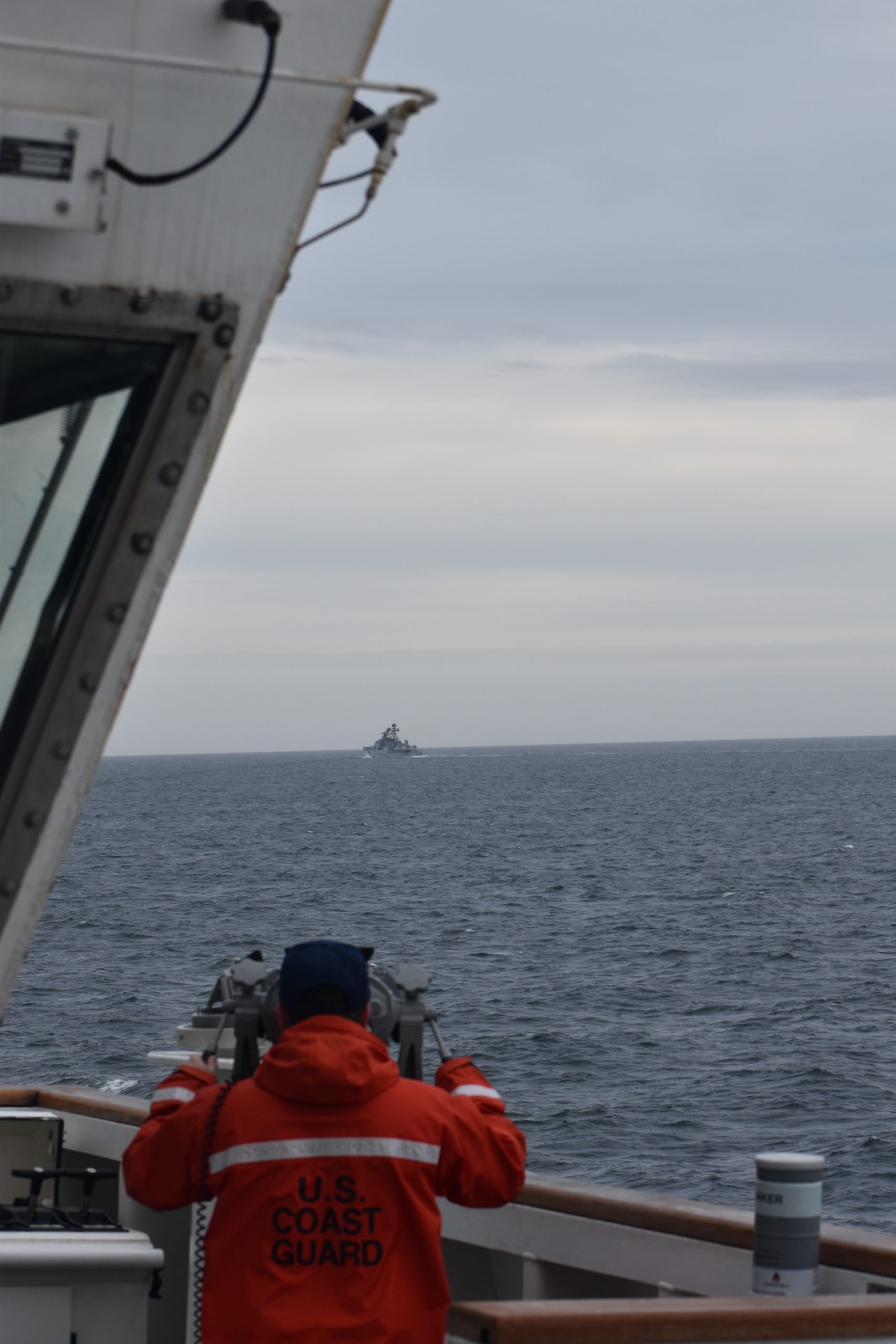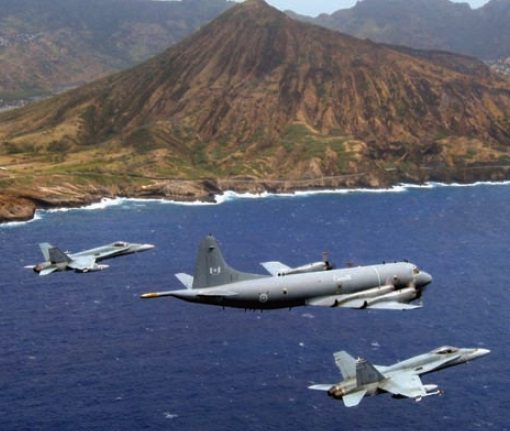By Dr. Andrea Charron, 21 October 2022
Headlines on 26 September 2022 repeated a US Coast Guard announcement (USCG). “The Coast Guard Cutter Kimball crew on a routine patrol in the Bering Sea encountered a People’s Republic of China Guided Missile Cruiser, Renhai CG 101, sailing approximately 75 nautical miles north of Kiska Island, Alaska, September 19, 2022.”
US Rear Admiral Nathan Moore, 17th Coast Guard District Commander, was quick to note that the vessels remained within international waters. What he also signalled was the importance of deterrence by detection and denial. In other words, the USCG will meet “presence-with-presence.”
This is not the first time that Chinese and Russia ships have travelled to the Bering Sea. Indeed, there is routine interaction between the USCG 17th District and Russian Border Guard Directorate for the Eastern Arctic District. China’s presence however, is newer although Chinese warships were found near the Aleutian Islands in August 2021 inside the United States Exclusive Economic Zone. It is still considered the high seas, but provocative nonetheless.
Some will insist a straight line may be drawn from Ukraine and this activity in the Arctic by Russia and China. I do not. Rather, the questions to ask is does this portend the likelihood of increased conflict? And, is this the direct result of the aggression by Russian on Ukraine? On the one hand, the behaviour of both Russia and China in the Arctic since 24 February 2022 has been muted. Rather than buzzing vessels and aircraft and jamming NATO’s GPS during Cold Response exercise held by Norway in 2022, Russia was more restrained than had been the case in past NATO exercises such as during Trident Juncture in March 2018. China generally stays physically far away from NATO Arctic exercises.
On the other hand, because of the heightened tensions, mishaps, accidents and incidents could escalate to a conflict quickly and so foreign warships in areas so close to the United States could be misinterpreted easily. Hawks will cry foul, doves will say let’s wait and see. They are both right and wrong.
If the international rules based order, a key interest for all Arctic states, included as a priority in successive Arctic strategies, is to be upheld, then ships will continue to have the right to transit in international waters, including the Bering Sea. It does mean, however, that the ability to detect, deny and deter so that vessels and air assets stay at a more comfortable distance from potential adversaries becomes more important. The Bering Strait falls within USNORTHCOM’s area of responsibly but it is along a seam with EUCOM and INDOPACOM. Likewise, the Aleutian Islands fall with USNORTHCOM but also on a seam with INDOPACOM. These seams, and the fact that USINDOPACOM owns many of the capabilities that USNORTHCOM requires, needs a review; seams are areas to exploit and to test command and control and communication across the combatant commands.

There is no straight line from the aggression against Ukraine by Russia to an inevitable conflict in the Arctic. Rather, there will be more tangential effects. Russia’s military has always reserved its best for the Arctic – strategically, it is its most consequential region to defend. The Northern Sea Route is still not the Panama Canal of the north Russia boasts it will be. Russia’s pariah status is undermining its status as an Arctic power and because the West is no longer communicating with Russia via a number of fora and events, activity, like the warships in the Bering Strait need to be watched carefully to minimize the risk of escalation.





3 thoughts on “China in the Bering Sea”
Hello Dr. Andrea Charron: These latest exercises with both Russia & China’s Navies in the Western Arctic are not new but they are increasingly disturbing and both Canada and the US should take pause to ask the question, why? Exercising with your allies is something the West has done for many years and this is no different. What is different is the force structure of both Russian and Chinese Task Groups operating together in the high Arctic, but it is what you don’t see that is more worrying. Like the West, there are and were most likely both Russian and Chinese SSNs operating there as well, along with more over-flights of military A/C from both countries and that should give both the RCN/Canada and the USN considerable consternation and concern. We may very well have seen the first steps towards Russian/Chinese domination of the high Arctic.
Hello,
No disrespect intended, but some impartial assessment of reality is missing from this article.
The tone implies that when “we” (meaning the US sphere) do something it’s OK, but when our competitors/adversaries do it, it’s concerning and problematic. We sail into Russian and Chinese EEZ regularly to “uphold freedom of navigation” and for military exercises, but if they do the same close to our EEZ, we are concerned about what it means. Russia is on the Bering Sea, so we should not be shocked that they and their allies can do what we do.
For laymen, what is the international rules based order? What rules, codified in which international laws, ratified by what countries? Better to directly cite the United Nations Convention on the Law of the Sea, as providing for “the right to transit in international waters”. Incidentally, the US is one of the very few non-signatories to the UNCLOS.
“The Northern Sea Route is still not the Panama Canal of the north Russia boasts it will be”
It’s on its way though. The Northern Route has seen consistent growth over the past 5 years to over 33 million tonnes of shipping by end 2021, and Russia’s development of its Arctic regions is massive, despite the West not communicating with it. Russia’s fleet of nuclear ice breakers and floating nuclear power plants is growing to service growth and traffic in the Arctic regions, so how is its status as an Arctic power diminished?
“Russia’s pariah status”
The countries sanctioning Russia are all NATO countries, minus Turkey, plus Australia and Japan, representing less than 15% of the world’s population. The value of the ruble is significantly higher than this time last year; the value of its oil and gas and all mineral exports are up; the US imports more of Russia’s oil; and the EU imports from Russia have increased over 2022, not decreased. Its grocery stores are fully stocked with children’s “Tylenol-skaya” and do not have “supply line issues”. Russian household debt sits around 20% of GDP compared to Canada’s 104% (mostly mortgages), Russian home ownership is at 90% (no mortgages) compared to Canada’s 66% (mortgaged to death). Russia has signed major trade deals across Eurasia, Africa, and South America, covering all sectors of its economy, and BRICS is expanding.
What would the metrics be like if it wasn’t a pariah?
I’m not trolling here, and my point is not to sing Russia’s praises. From my civilian, non-academic view, it looks like we are losing our ability to dominate the world, and other countries (Russia and China among others) are exercising their ability to uphold their interests and effectively push us out. We are now losing our ability to compete; we have lost our economic and technological dominance; and our value proposition is dropping fast. Stemming from that, we have lost our ability to impose our “democratic” will on non-NATO countries.
We do not like it, but we should adapt to this new reality sooner rather than later, and start communicating openly and fairly with these competitors, because USCOM watching and worrying about their activities won’t keep the world from turning.
Good afternoon Curious Civilian,
Could you provide the references that you used to establish how wonderfully things are going in Russia?
For a discussion of the weaknesses of China (and secondarily Russia) I would suggest the following book.
(https://www.amazon.ca/Unrivaled-America-Superpower-Cornell-Security-ebook/dp/B07C38TCHJ/ref=sr_1_1?crid=2ZTS1HZODVO23&keywords=unrivaled&qid=1671307720&sprefix=unriva%2Caps%2C143&sr=8-1)
While I am not convinced by the author’s key thesis, I do not think that his laying out of China’s numerous and worsening internal problems can be simply ignored. Russia’s problems are also touched on, but in less detail. This likely reflects its junior partner status compared to China.
For consideration.